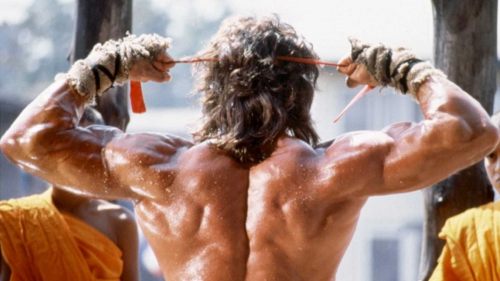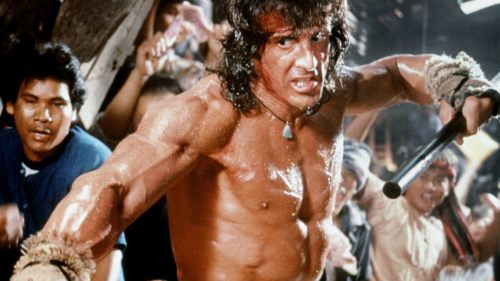RAMBO: By The Book
Alamo Drafthouse's Rambo marathon leading up to Rambo: Last Blood is almost here. Get your tickets now!
"In my novel First Blood, Rambo died. In the films, he lives."
This is all the attention David Morrell gives to the continuity problem of continuing a series of novels where the protagonist didn’t survive the first installment. First Blood, written a decade before the Stallone adaptation made Rambo a household name, remains largely a separate entity, even to Morrell’s own sequels. But in taking on the print versions of those follow-ups, plotted by other people, Morrell had a specific agenda. "I was fascinated to see how… in Rambo: First Blood Part II, Rambo was interpreted as a jingoistic superhero," Morrell says in his memoir Rambo and Me. Morrell’s novelizations of that film and the subsequent Rambo III see the author deliberately recalibrating the screen Rambo as far back towards his original vision as is possible. The bones of the plots remain the same, but while relations between author and actor remain cordial, Morrell’s print Rambo is something of a rebuke to Stallone’s.
In the novel of First Blood, Rambo isn’t even necessarily a hero. The chapters alternate between the points of view of Rambo and Teasle, who represent the divide between older establishment and youth counterculture of the last '60s and early '70s. Teasle isn’t the bully he seems in the movie, and Rambo isn’t the victim. Teasle is an Eisenhower Republican and decorated Korean War hero. Rambo is a radicalized Vietnam vet. One of the most fascinating things about the novel is the way in which notions of hero and bad guy hinge entirely on the reader’s age and politics. It’s genuinely possible to read it both ways (Paul Newman was apparently interested in a pre-Stallone screen iteration in which he would have played Teasle as the starring role). At the novel’s end, in the ruins of the town, Trautman puts Rambo down like a dog.
"My Rambo is furious about his war experience," says Morrell. "He hates what he was forced to do, and he especially hates that he discovered he had a skill for killing. It’s the only thing he knows how to do, but he’s a genius at it."
Morrell was contractually the only author allowed to write Rambo novels, which is why the producers had to use him if they wanted novelizations in bookstores, and why he was given unusual leeway to do what he saw fit with the projects. His First Blood Part II – the film of which he cheerfully describes as "a cross between a Western and a Tarzan movie" – pulls more from James Cameron’s early screenplay draft than the one that reached the screen. It begins, as does the film, with Rambo breaking rocks in the hot sun (he fought the law and the law won), but the meeting between him and Trautman takes place in Rambo’s prison (possibly asylum, although this isn’t specified) cell, in which Rambo has broken the lights so that he can crouch menacingly in the dark. "Thinks he’s the fucking prince of darkness," a guard explains. On his way to his rendezvous in Thailand, Rambo makes sure to lose the agents tailing him and show up in his own time and on his own terms. He still gets there, so it makes no particular difference in story terms, but it shows he’s deliberately defying the higher-ups right from the off, just to show his contempt. And it’s not "hell" he calls home in this version, it’s "hostile territory".
The beats of the lean, mean action adventure remain the same, but there are other significant tweaks. The POW camp that’s Rambo’s destination is, in the novel, the same camp from which he previously escaped, making this return to 'Nam far more personally significant to Rambo than it is on screen. Sergeant Tay – the skinny, mustachioed guard played by George Cheung – is a ghost from Rambo’s past, the sadistic torturer responsible for many of Rambo’s scars, both physical and psychological. Co (Julia Nickson’s character) is a much older war widow with an economics degree, a son in the States, and, y’know, some personality and agency. And the Russian Lieutenant Podovsk (Steven Berkoff, named Podovsky in the film) is another sadist, rather explicitly excited by the infliction of suffering.
Otherwise the differences are of tone and pacing. Obviously the novel is able to dig deeper into scenes than the film’s brisk 90 minutes – we spend a lot longer in the slime pit. But that "jingoism" that Morrell noted is completely excised. There’s no angry speechifying at the end about being loved by his country. This Rambo doesn’t give a shit about country or politics. "The trick is to survive," is his shrugged final line. "What else is there?"
Morrell’s Rambo III strays even further from its movie counterpart – perhaps understandably given the compromised production. "With each successive [screenplay] draft, the story got simpler and simpler until it was merely a failed rescue attempt and a successful rescue attempt," Morrell recalled. So he simply novelized the original "epic" draft that, in the early stages of development, he’d actually found "very exciting".
Rambo here is even angrier and more consumed with self-loathing than previously, following the death of Co. He lives at the monastery but he isn’t helping to build it with the zen-like contentment of Stallone’s filmed scenes. During the day he works in a foundry, mindlessly pounding metal, and he’s drawn, against his will, into moonlighting as a nighttime stick fighter, not for "a little extra money" but for the punishment. He’s a violence addict, trying not to relapse, but failing.
His journey from Pakistan into Afghanistan with Mousa is punctuated by a lot of detailed exposition from the latter about Afghan culture and the Soviet-Afghan War. Morrell is careful to get those details correct, and clearly enthused by placing Rambo in the position of fighting with the indigenous soldiers against the invading force: a smart inversion of Rambo’s Vietnam experience, in a completely different environment. There’s a massive sandstorm in which Rambo and Mousa are trapped. Rambo downs two Soviet helicopter gunships above an evacuated village (Morrell’s budget is, of course, infinite, so where the film has a couple of impressive helicopters, Morrell employs a fleet of more than thirty). Reaching the makeshift camp, Rambo and Mousa liaise with the mujahideen leaders Khalid, Mosaad and Rahim: leaders of separate tribes with different agendas; delineated characters with dialogue. Also in the camp is Dutch Red Cross medic Michelle Pillar, who doesn’t feature in the film at all.
Rambo’s game of dead calf polo here actually serves a narrative purpose, winning the respect of the mujahideen. The three leaders agree to work together to help Rambo free Trautman, but only if Rambo first aids them in ambushing a Soviet convoy in a valley. Rambo rigs the valley with remote controlled explosives, and the plan goes slightly awry but is ultimately successful, with a tank and another helicopter gunship destroyed. This is where we meet Andreyev (the film’s "Uri"), a Russian who hid during the battle. The Afghans want to execute him but Rambo persuades them otherwise. Andreyev knows the location of the Soviet fort and the route through the minefield, and he stays with Rambo until he’s killed during Trautman’s rescue. It’s a much bigger role than Shaby Ben-Aroya’s in the film, where he’s already living with the mujahideen for unexplained reasons and only lives long enough to draw a map.
Speaking of Russians, we get to know three others in detail in the novel. Colonel Zaysan – Marc de Jonge’s character, spelt “Zaysen” in the credits – is the sadistic leader who orders children to be tortured with acid to upset his prisoner Trautman. He despises his superiors and his Afghan posting. Sergeant Kourov – Randy Raney’s massive henchman character who in the film is wordless, hanged and exploded in a cave – here doesn’t die and ultimately defects to the mujahideen because he loves the warrior life. He’s sort of the anti-Rambo. And finally we have Major Azov – who isn’t in the film at all (Superman IV’s Mark Pillow was in talks to play him before the role was excised). Azov is another Russian Rambo, but in this case a mirror image who similarly hates war and his superiors, but knows nothing else and is insanely good at it.
The rescue of Trautman is successful first time out. Rambo and his team enter the fortress quietly but leave noisily, trapping the Russian officers in cell full of tear gas, destroying the building and blowing up the mine field. Azov has the opportunity to kill Rambo with a sniper shot, but opts not to, reasoning that it’s not his fight. Trautman is in the sort of shape Jim Caviezel was in towards the end of The Passion, and has to be carried all the way back the mujahideen camp in a fireman’s lift, where Michelle sets up a gnarly blood transfusion in a cave.
After which the three mujahideen tribes go their separate ways once again, and Rambo, Michelle and Mousa head East across the mountains back to Pakistan, with Trautman on a makeshift bier carried between Rambo and a horse. In the mountains, snipers take shots at Rambo, and his grenade response causes a massive avalanche. Our heroes endure exhaustion, depression and stress. Horses bolt. Mousa is shot in the thigh and Michelle breaks an arm. Descending into the warmth of another valley with some relief, the four encounter another gunship and all hope is lost… until the mujahideen arrive to save the day. The three leaders have individually encountered signs of potential ambushes and turned around for a final stand. In the ensuing massive battle with guns and grenade launchers and horses and armored personnel carriers, Rambo’s horse jumps over a tank and Rambo stabs Zaysan through the head with his massive knife thrown from mid-air.
The battle over, Rambo reflects that maybe he can turn his monstrous talents towards being an ultra-violent Robin Hood. "He had a meaning. He served a purpose."
The book includes no double-dealing gun seller, no cute kid, no protracted cave-set action sequences and no helicopter/tank face-off. Instead, it’s Rambo of Arabia, with all the scale that suggests, but little of the "white saviour" aspect. He doesn’t go to Afghanistan to save and lead the mujahideen. He just needs their help, and has to earn it. There’s even an interesting thread about Rambo absorbing the religion of wherever he embeds. We’ve seen him flirt with Buddhism before. Here he gets pretty close to accepting Islam. There’s a lot of inshallah. Rambo’s philosophy, essentially, is whatever works. The trick is to survive. What else is there?
David Morrell’s First Blood is published in the US by Grand Central and in the UK by Headline. His novelizations of Rambo: First Blood Part II and Rambo III are available digitally from Morrell’s own self-publishing imprint (as is the fascinating Rambo and Me). He didn’t novelize 2008’s Rambo because he thought the movie got the character right. His thoughts on Last Blood are not yet on record…



